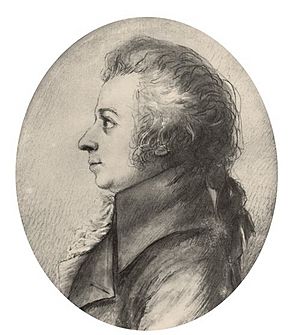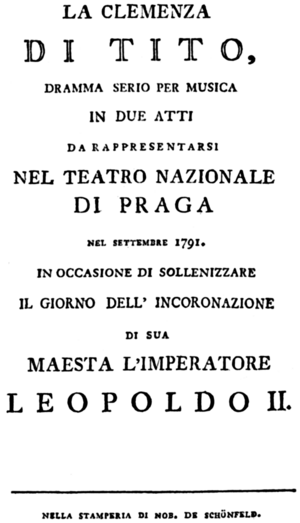La clemenza di Tito facts for kids
Quick facts for kids La clemenza di Tito |
|
|---|---|
| by W. A. Mozart | |

The composer, drawing by Doris Stock, 1789
|
|
| Genre | Opera |
| Translation | The Clemency of Titus |
| Librettist | Caterino Mazzolà |
| Language | Italian |
| Based on | libretto by Pietro Metastasio |
| Premiere | 6 September 1791: Estates Theatre, Prague |
La clemenza di Tito (which means The Clemency of Titus) is a famous opera by Wolfgang Amadeus Mozart. It's an opera seria, which is a serious type of opera from the 1700s. The story is sung in Italian and was written by Caterino Mazzolà, based on an older story by Pietro Metastasio. Mozart wrote this opera in 1791, the same year he was working on The Magic Flute. The Clemency of Titus was first performed on September 6, 1791, in Prague.
Contents
Creating the Opera: A Royal Request
In 1791, the last year of his life, Mozart was very busy. He was already writing The Magic Flute when he got a special request. An event organizer named Domenico Guardasoni asked him to write a new serious opera. This opera was needed for a big celebration in Prague.
The celebration was for the coronation of Leopold II, Holy Roman Emperor. He was becoming the King of Bohemia (a region in today's Czech Republic). The local leaders in Bohemia wanted to make a political agreement with Leopold. They wanted to keep their power and avoid changes that Leopold's brother had tried to make. So, this opera was meant to help show off the new king and keep the peace.
Guardasoni had a tight deadline, with the coronation set for September 6. He promised to find a great singer and a "distinguished maestro" (a famous composer) for the music. If he couldn't get a new story, he would use an old one.
An Old Story Gets a New Tune
The story for The Clemency of Titus was an old one. It was written over 50 years earlier by Pietro Metastasio. Many composers had already used it. The story is about the Roman Emperor Titus. Mozart had seen a version of this story performed when he was a child.
Mozart wasn't the first choice for the opera. Guardasoni first asked Antonio Salieri, a very famous Italian opera composer in Vienna. But Salieri was too busy. So, Mozart got the job!
The old story was updated by a poet named Caterino Mazzolà. He made the original three-act story into two acts. He also added more group singing parts (called ensembles) and a new ending for the first act. This made the opera feel more exciting and dramatic.
A Race Against Time
Mozart was known for working fast. He had shown this when he composed Don Giovanni. He was happy to take on this new project because the payment was very good.
Some people say Mozart finished the opera in just 18 days! It was done so quickly that another composer, probably Mozart's student Franz Xaver Süssmayr, might have written the simple spoken parts (called secco recitatives). We know Süssmayr traveled with Mozart to Prague to help with rehearsals. Even if it wasn't exactly 18 days, it was still incredibly fast. The Clemency of Titus is one of the fastest-written operas that is still performed a lot today.
Opera Performances: A Long History

The first performance of The Clemency of Titus happened just a few hours after Leopold's coronation. It was performed at the Estates Theatre in Prague on September 6, 1791. A special clarinet player, Anton Stadler, traveled with Mozart to play in the orchestra. Mozart wrote two very important solo parts just for him in the opera.
For many years after Mozart's death, the opera stayed popular. It was the first full Mozart opera to be performed in London in 1806. It was also performed at famous opera houses like La Scala in Milan and had its first North American performance in 1952.
For a long time, some music experts didn't think The Clemency of Titus was one of Mozart's best works. They thought he wrote it too quickly and that the characters weren't very deep. However, in more recent years, people have started to appreciate it much more. Many now see it as a noble and warm piece of music. Today, it is still performed regularly in major opera houses around the world.
Recent performances include the Salzburg Festival in 2017, Glyndebourne's festival in 2017, and the Los Angeles Opera and Metropolitan Opera in 2019.
Main Characters
This table shows the main characters in the opera, their voice types, and who first played them.
| Role | Voice type | Premiere cast 6 September 1791 |
|---|---|---|
| Tito Vespasian, Roman Emperor | tenor | Antonio Baglioni |
| Vitellia, daughter of the deposed Emperor Vitellio | soprano | Maria Marchetti-Fantozzi |
| Sesto, a young patrician, friend of Tito, in love with Vitellia | soprano; often sung by mezzo-soprano or countertenor today |
Domenico Bedini |
| Annio, a young patrician, friend of Sesto, in love with Servilia | soprano (played by a woman dressed as a man); usually sung by mezzo-soprano |
Carolina Perini |
| Servilia, sister of Sesto, in love with Annio | soprano | Antonina Campi, née Mikłaszewicz (also called Signora Antonini) |
| Publio, Praetorian prefect, commander of the Praetorian Guard | bass | Gaetano Campi |
Music and Instruments
The opera uses a full orchestra. This includes two flutes, two oboes, two clarinets (one also plays basset clarinet and basset horn), two bassoons, two French horns, two trumpets, timpani (kettledrums), and strings (violins, violas, cellos, basses). For the simple spoken parts, a harpsichord and cello play the background music. Sometimes, a fortepiano (an early piano) is used instead of a harpsichord.
The Story of The Clemency of Titus
The story takes place in Ancient Rome in the year 79. It's a tale of love, betrayal, and forgiveness.
Act 1: A Plan for Revenge
Vitellia, whose father was once emperor but was removed by Tito's father, wants revenge on Tito. She is jealous because Tito might choose someone else to be his empress. She convinces Sesto, who is deeply in love with her, to plot against Tito. Sesto agrees to do whatever she asks.
But then, Vitellia hears that Tito has sent away Berenice, a woman she was jealous of. Vitellia hopes Tito will now choose her as his empress. So, she tells Sesto to wait and not carry out the plan yet.
However, Tito decides to marry Servilia, who is Sesto's sister. He asks Annio, Sesto's friend, to tell Servilia the news. This is bad news for Annio and Servilia, because they are secretly in love with each other. Servilia bravely decides to tell Tito the truth about her love for Annio. Tito is very understanding. He praises Servilia for her honesty and immediately changes his mind. He decides not to marry her, so she can be with Annio.
Meanwhile, Vitellia hears that Tito chose Servilia, not her. She becomes furious with jealousy again. She immediately urges Sesto to assassinate Tito. Sesto agrees, singing a famous song about his difficult choice. Right after Sesto leaves, Annio and Publio (a guard) arrive to take Vitellia to Tito. Tito has now chosen Vitellia to be his empress! Vitellia is filled with guilt and worry about what she just told Sesto to do.
Sesto and his friends set fire to the Capitol building. Everyone else is horrified by the fire. Sesto returns and says he saw Tito killed. But Vitellia stops him from saying he was the killer. Everyone mourns Tito at the end of the first act.
Act 2: Forgiveness and Mercy
Annio tells Sesto that Emperor Tito is actually alive! Sesto had mistaken someone else for Tito in the smoke and confusion. Sesto wants to run away from Rome, but Annio convinces him to stay.
Soon, Publio arrives to arrest Sesto. It turns out one of Sesto's friends dressed in Tito's robes and was stabbed by Sesto, but not fatally. The Roman Senate (a group of leaders) tries Sesto for his crime. Tito waits, hoping his friend will be found innocent. Publio expresses his doubts about Sesto. Annio begs Tito to be merciful to his friend.
Publio returns and announces that Sesto has been found guilty. A heartbroken Tito must sign Sesto's death sentence. Tito decides to speak with Sesto first. Sesto takes all the blame and says he deserves to die. Tito tells him he will get his wish and sends him away.
But after a long struggle with himself, Tito tears up the death warrant. He decides that if people are going to criticize him, he wants them to say he was too merciful, not that he was vengeful.
Vitellia is now overcome with guilt. Servilia warns her that tears alone won't save Sesto. Vitellia finally decides to confess everything to Tito, even if it means losing her chance to be empress. In the amphitheater, Sesto and others are waiting to be thrown to wild animals. Tito is about to show mercy when Vitellia confesses that she was the one who started the plot.
Even though he is shocked, the emperor includes her in his general act of mercy. The opera ends with everyone praising Tito's incredible generosity. Tito then asks the gods to end his life if he ever stops caring about the good of Rome.
Images for kids
See also
- List of operas by Mozart
 In Spanish: La clemencia de Tito (Mozart) para niños
In Spanish: La clemencia de Tito (Mozart) para niños





